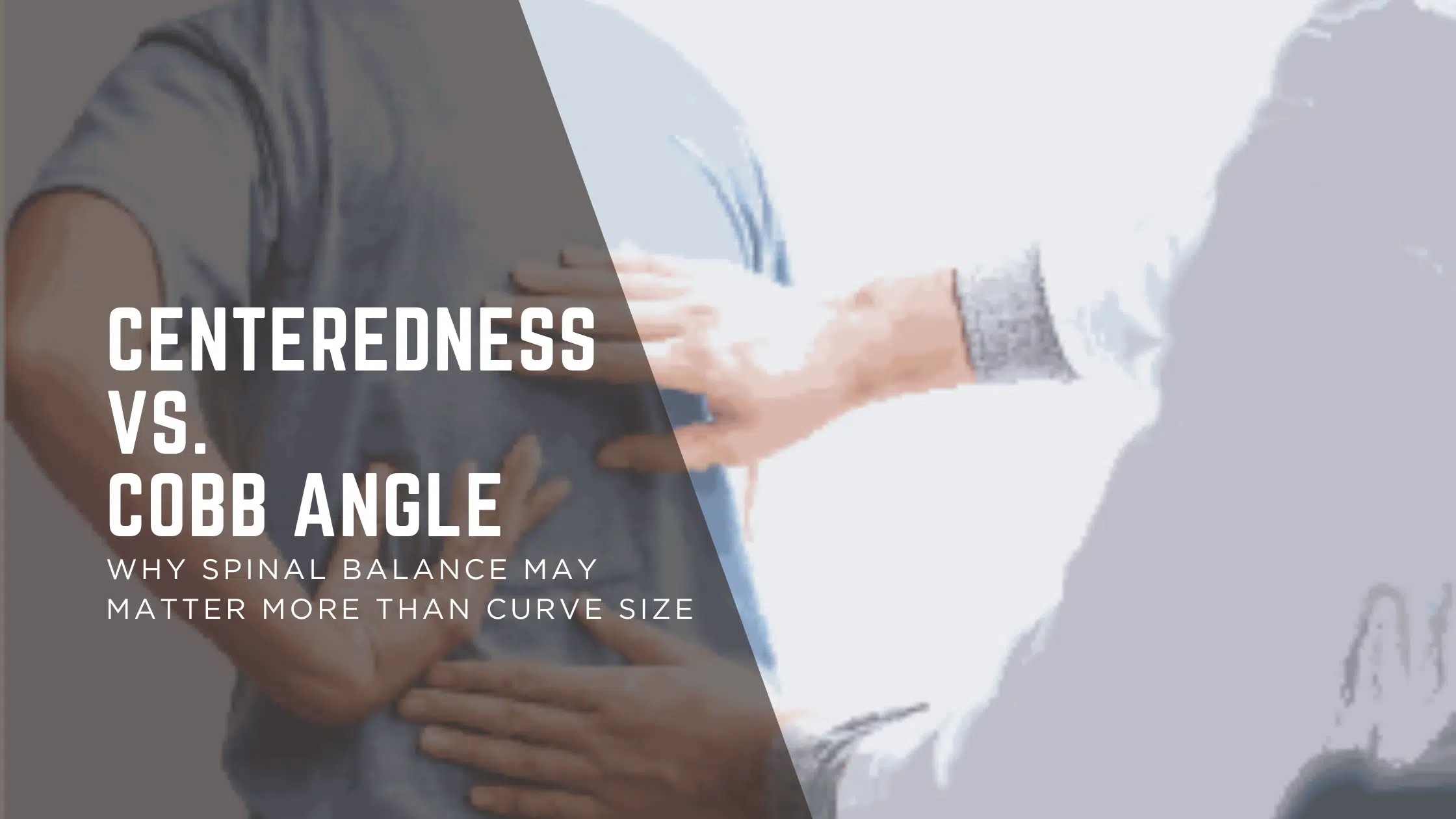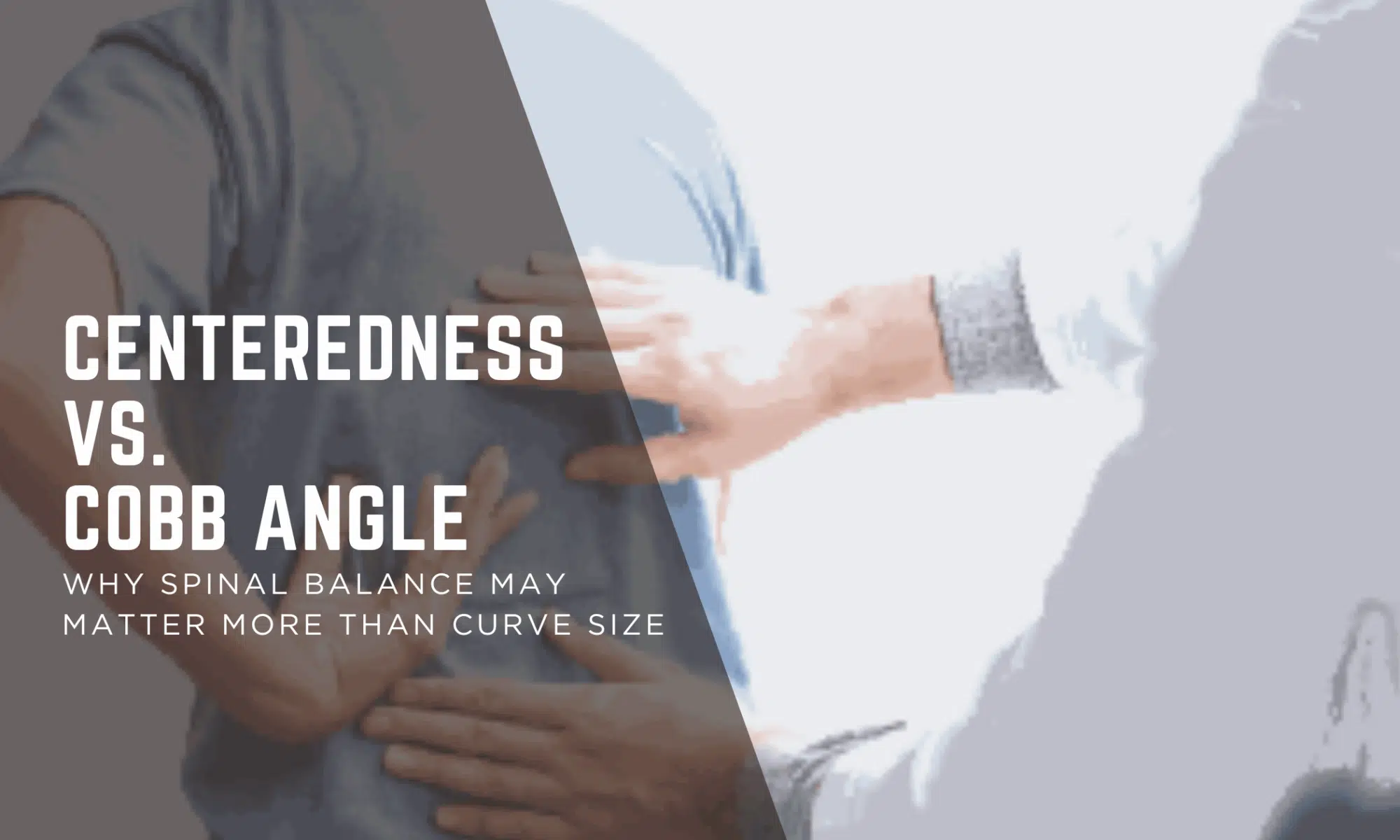
Centeredness vs. Cobb Angle: Why overall spinal balance may be a better predictor for risk of progression and future pain than size of curve
When it comes to assessing scoliosis and spinal deformities, the Cobb angle has long been the gold standard for diagnosis and treatment planning. The Cobb angle measures the degree of curvature in the spine, quantifying its deviation from a straight vertical line. However, Cobb angle does not take into account centeredness of the spine (how balanced the spine is left to right of midline, and how centered the head is over the sacrum.). While measuring Cobb angles has proven useful, emerging research, and our clinical experience, suggest that the centeredness of the spine—or how well the spine is balanced over the pelvis—may be a more critical factor in predicting risk of progression, future pain, functionality, and quality of life.
What exactly do I mean by centeredness? Centeredness refers to the alignment of the spine relative to the body’s midline. If you were to draw a vertical line from the middle of the sacrum (base of the spine) up through the body, it should intersect the center of the skull. If the line does not intersect perfectly, it indicates that the majority of the spine has shifted to one side, making the whole torso off-center. This can occur on all types of curves but we frequently observe this in patients with “C”-shaped curves, where the patient’s torso appears to lean to the left or right, and many of these patients can have relatively low Cobb angles. On the other hand, we frequently see larger curves that appear more balanced, especially in “S”-shaped curves. In these types of curves, a patient has both a thoracic, and lumbar, curve that essentially balance each other out, making the overall alignment appear more centered. These types of curves tend to be more stable in adulthood, regardless of the Cobb angle, compared to more translated, or shifted, curves.
In this blog, I’ll argue why spine alignment, specifically the degree to which the spine is balanced over the body’s center of gravity, can be a more reliable predictor for risk of progression, and pain, than the cobb angle alone.
The Problem with Solely Relying on Cobb Angle
The Cobb angle is very useful for quantifying the severity of scoliosis, but it has its limitations. Cobb angle doesn’t account for translation of the spine; so, a patient may have a relatively low Cobb angle but still be at a high risk for developing back pain due to an imbalance in how the spine stacks over the pelvis [3][5]. In other words, a “mild” curve could still cause significant discomfort if it has “shifted” too far one way or the other. How? Well, patients often develop compensatory curves and muscle imbalances to keep their head, shoulders, and hips aligned [9]. These adaptations need to be taken into account when predicting future complications like pain or loss of function [4]. One very important compensatory curve that is often over looked by practitioners is called the Lumbosacral angle.
The lumbosacral angle in scoliosis refers to the angle formed between the lumbar spine and the sacrum. It is a critical parameter in assessing spinal alignment. This angle helps clinicians evaluate how much the curvature of the spine affects the lower back and pelvis. Measuring the lumbosacral angle is important because it influences the biomechanics of the spine, posture, and the distribution of weight across the pelvis and legs. Accurate measurement helps guide treatment plans, monitor progression, and determine the need for interventions like bracing or surgery to prevent further deformity and associated complications such as pain, mobility issues, or nerve compression. Like mentioned earlier, most practitioners, including surgeons, have a tendency to ignore the lumbosacral angle and solely focus on the primary curve. By doing this, they are ignoring the part of the spine, based on our clinical experience, is most likely to develop pain later on in life, if left untreated.
The Importance of Centeredness and the Lumbosacral angle: How Low Back Mis-alignment Can Lead to Pain
It Basically comes down to gravity and load distribution. The human body is designed to function most efficiently when its various structures are aligned over the center of gravity [7]. When the spine is centered over the pelvis, the body can distribute weight more evenly, reducing stress on the joints, ligaments, and muscles [5]. A spine that deviates from this centered position forces the body to compensate by overworking certain muscle groups or placing excessive strain on the spine’s discs and vertebrae structures [7]. Over time, this can lead to chronic pain, degeneration, and other complications [6]. Over time, gravity will aid in this process of translation and contribute to the collapse of the lumbar spine. [6]. This shift underlines the growing recognition that centeredness—not just the degree of curvature—plays a vital role in patient outcomes [8].
Real-World Implications
In clinical settings, treatment plans should not be formulated solely on the size of curve. There are many factors that need to be taken into account before a treatment plan is made. This goes for surgical, and non-surgical practitioners. These factors must include Age, Risser score, Cobb angle, and Centeredness. For example, a patient with a relatively small curve might be at a higher risk of progression and/or experience significant discomfort if the spine is significantly translated, leading to constant tension in the lower back muscles [3]. Meanwhile, another patient with a larger Cobb angle may be at lower risk of progression and report little or no pain if their spine remains well-centered and balanced [5].
When predicting future pain and degeneration of the spine you must understand that misalignment of the spine places extra pressure on specific areas of the spine, especially the intervertebral discs [7]. Over time, this leads to wear and tear, accelerating the onset of conditions like degenerative disc disease and osteoarthritis [9]. In contrast, a spine that remains well balanced and centered—even with a large cobb angle—may distribute loads more evenly, minimizing the long-term impact on the body’s structure [6].
It is my hope with this blog that both surgical and non-surgical practitioners began to understand the importance of centeredness and balance of the spine rather that solely focusing on the cobb angle. This more holistic approach will help clinicians provide better care and more accurately predict pain, disability, and long-term outcomes, shifting the emphasis from merely reducing the degree of curvature to improving the overall balance and alignment of the spine [9]. While the Cobb angle remains a valuable tool for diagnosing and quantifying spinal deformities, its limitations become apparent when we are attempting to predict future complications. As clinicians continue to evolve their understanding of scoliosis, it’s becoming increasingly clear that overall spinal balance—not just curvature—holds the key to properly managing patients with scoliosis.
Resources
- Cobb, J. R. (1948). Outline for the Study of Scoliosis.
- Weinstein, S. L., et al. (2008). Adolescent Idiopathic Scoliosis: Natural History and Long-Term Treatment Effects.
- Glassman, S. D., et al. (2005). The Impact of Positive Sagittal Balance in Adult Spinal Deformity. Spine Journal.
- Diebo, B. G., et al. (2015). Sagittal Alignment of the Spine: What Do You Need to Know? Clinical Neurology and Neurosurgery.
- Vialle, R., et al. (2005). Radiographic Analysis of the Sagittal Alignment and Balance of the Spine in Asymptomatic Subjects. The Spine Journal.
- Schwab, F., et al. (2013). Surgical Planning for Sagittal Imbalance: The Importance of Pelvic Incidence, Pelvic Tilt, and Lumbar Lordosis. The Spine Journal.
- Panjabi, M. M. (1992). The Stabilizing System of the Spine: Part I and Part II. Journal of Spinal Disorders.
- Scoliosis Research Society (SRS). Multidimensional Assessment of Spinal Deformities.
- Barrey, C., et al. (2010). Sagittal Balance Disorders in Severe Degenerative Spine: Can We Identify the Compensatory Mechanisms? European Spine Journal.
- Hostin, R., et al. (2013). Predictors of Long-Term Outcomes Following Adult Spinal Deformity Surgery.

